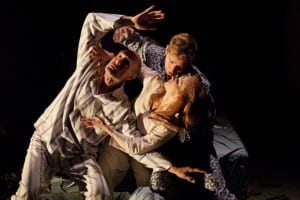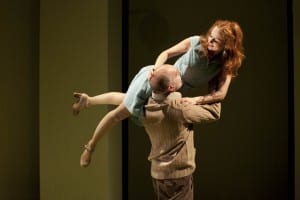Through discussion and exploration as a company, we have begun to shape our performance into a narrative that follows seven strong characters, and we have finally arrived at a destination for our shows name: Kalopsia. Kalopsia has developed from focusing specifically on love, to focusing on individuals and their hopes, dreams, and true selves. Our performancehas therefore been shaped to consist of two modes of performance: office life, and delusions. There is a stark contrast between these two modes, the office life is performed in a realistic format, whereas the delusions are artistic, contemporary representations of the limitless possibilities of the imagination. The delusions are where my focus as choreographer is, as particular styles of movement and physical theatre come into play.
The first delusion is a representation of a silent movie. Because of the lack of sound in this form, the physicality has to be visually gripping and have clear indicators as to what is happening, as well as having a strong storyline to keep viewers gripped. This is achieved through the archetypal use of a hero, a villain, and a damsel in distress. Such characteristics are seen in Commedia Dell’Arte, and so physical characterisation from this era of theatre can be put into practice.
To begin my research, I took the three characters of the villain, hero and damsel, and analysed the different movements each would adopt.
The villain is typically a suited or caped man with a moustache, who hunches over and rubs his hands together. Of the Commedia Dell’Arte characters, I related our villain closely to Brighella: “he is capable of intrigue, deceit, making a mockery of the entire world with his mordant, salacious wit” (Rudlin, 1994, 86). He can woo the ladies with his persuasion and “rakish attraction” (ibid, 87). He also stays calm whilst hatching his cunning plans, but gets more excited as his plans spring into action.
The hero, on the other hand, stands tall and strong which the stereotypical ‘hero’ gestures on crossing the arms or showing his strength. Despite this, our hero is more of a wishful thinker. I have related this character to Pedrolino/Pierrot. Though he suffers constant unrequited love, and he is “bottom of the pecking order[, …] he never loses his dignity” (ibid, 134), much like our hero of the silent movie delusion.
The Damsel in distress is especially feminine, and relies solely on the hero to save her. I have connected this archetype to the innamorata (female lover); it is known of these characters that “[t]he Lovers exist very much in their own world” (ibid, 109). Our damsel is especially similar to the famous Isabella, who is a “prima donna […] developed from innamorata, but less dilettante, more perspicacious” (ibid, 116).
I have passed on my conducted research to the actors of these characters, with the intention for them to begin to study their characterisation and physicality. These Commedia Dell’Arte characters provide the actors in this scene with a base point on which to physically act and what gestures and stances to incorporate. I will work more on their physicality once an understanding on the characters has been established.
The silent movie genre has very particular characteristics; namely, the overdramatised gestures and physicality of archetypes. Charlie Chaplin (1889-1977), one of the most famous silent movie actors of his time, was my next point of reference when researching for this delusion. His very particular and peculiar walk clearly shows the overdramatised style that we need in our first delusion.
A primary part of the silent movie scene is drawn on the well-known cliché of tying a woman tied to the train tracks. We drew from this to emphasise the overdramatisation and delusion aspect of the scene, and tap into the well known aspects of the medium. This also offered a strong storyline for us to follow which would be easy for the audience to understand, which explained above is important for a medium that lacks dialogue and speech. Also, evident from the Charlie Chaplin video above, there is a sped up nature to silent movies, and so within the movements I aim to keep a heightened pace to represent this without it looking rushed. We made sure to draw on the comedic element of silent movies as this is something which has prospered throughout its history . I believe physical comedy is a strong way to begin our performance of Kalopsia as it engages the audience’s attention and prepares them for further moments of humour in the following scenes of the play.
JoseMonkeys (2011) Charlie Chaplin – The Lions Cage. [online video] Available from https://www.youtube.com/watch?v=mpjEyBKSfJQ&feature=youtu.be [Accessed 8 April 2017].
Rudlin, J. (1994) Commedia Dell’Arte an Actor’s Handbook. London: Routledge.

